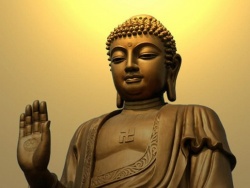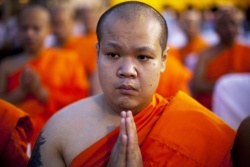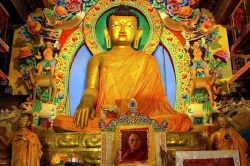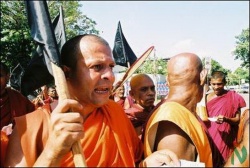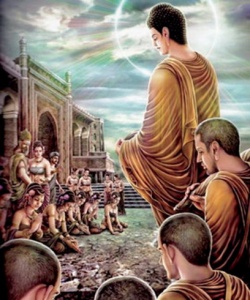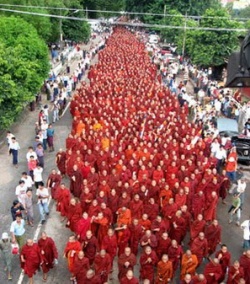Distorted Visions of Buddhism: Agnostic and Atheist By B. Alan Wallace
As Buddhism has encountered modernity, it runs against widespread prejudices, both religious and anti-religious, and it is common for all those with such biases to misrepresent Buddhism, either intentionally or unintentionally. Reputable scholars of Buddhism, both traditional and modern, all agree that the historical Buddha taught a view of karma and rebirth that was quite different from the previous takes on these ideas. Moreover, his teachings on the nature and origins of suffering as well as liberation are couched entirely within the framework of rebirth. Liberation is precisely freedom from the round of birth and death that is samsara. But for many contemporary people drawn to Buddhism, the teachings on karma and rebirth don’t sit well, so they are faced with a dilemma. A legitimate option simply is adopt those theories and practices from various Buddhist traditions that one finds compelling and beneficial and set the others aside. An illegitimate option is to reinvent the Buddha and his teachings based on one’s own prejudices. This, unfortunately, is the route followed by Stephen Batchelor and other like-minded people who are intent on reshaping the Buddha in their own images.
The back cover of Batchelor’s most recent book, entitled Confession of a Buddhist Atheist, describes his work as “a stunning and groundbreaking recovery of the historical Buddha and his message.” One way for this to be true, would be that his book is based on a recent discovery of ancient Buddhist manuscripts, comparable to the Dead Sea Scrolls or the Nag Hammadi library for Christianity. But it is not. Another way is for his claims to be based on unprecedented historical research by a highly accomplished scholar of ancient Indian languages and history. But no such professional research or scholarship is in evidence in this book. Instead, his claims about the historical Buddha and his teachings are almost entirely speculative, as he takes another stab at recreating Buddhism to conform to his current views.
To get a clear picture of Batchelor’s agnostic-turned-atheist approach to Buddhism, there is no need to look further than his earlier work, Buddhism without Beliefs. Claiming to embrace Thomas Huxley’s definition of agnosticism as the method of following reason as far as it will take one, he admonishes his readers, “Do not pretend that conclusions are certain which are not demonstrated or demonstrable.”[1] He then proceeds to explain who the Buddha really was and what he really taught, often in direct opposition to the teachings attributed to the Buddha by all schools of Buddhism. If in this he is following Huxley’s dictum, this would imply that Batchelor has achieved at least the ability to see directly into the past, if not complete omniscience itself.
Some may believe that the liberties Batchelor takes in redefining the Buddha’s teachings are justified since no one knows what he really taught, so one person’s opinion is as good as another’s. This view ignores the fact that generations of traditional Buddhists, beginning with the first Buddhist council shortly following the Buddha’s death, have reverently taken the utmost care to accurately preserve his teachings. Moreover, modern secular Buddhist scholarship also has applied its formidable literary, historical, and archeological skills to trying to determine the teachings of the Buddha. Despite the many important differences among Theravada, Mahayana, and Vajrayana schools of Buddhism, traditional Buddhists of all schools recognize the Pali suttas as being the most uncontested records of the Buddha’s teachings.
In the face of such consensus by professional scholars and contemplatives throughout history, it is simply an expression of arrogance to override their conclusions simply due to one’s own preferences or “intuition” (which is often thinly disguised prejudice). To ignore the most compelling evidence of what the Buddha taught and to replace that by assertions that run counter to such evidence is indefensible. And when those secular, atheistic assertions just happen to correspond to the materialistic assumptions of modernity, it is simply ridiculous to attribute them to the historical Buddha.
For example, contrary to all the historical evidence, Batchelor writes that the Buddha “did not claim to have had experience that granted him privileged, esoteric knowledge of how the universe ticks.” To cite just two of innumerable statements in the Pali canon pertaining to the scope of the Buddha’s knowledge: “Whatever in this world – with its devas, maras, and brahmas, its generations complete with contemplatives and priests, princes and men – is seen, heard, sensed, cognized, attained, sought after, pondered by the intellect, that has been fully awakened to by the Tathagata. Thus he is called the Tathagata.”[2] In a similar vein, we read, “the world and its arising are fully known by a Tathagata and he is released from both; he also knows the ending of it and the way thereto. He speaks as he does; he is unconquered in the world.”[3]
Batchelor brings to his understanding of Buddhism a strong antipathy toward religion and religious institutions, and this bias pervades all his recent writings. Rather than simply rejecting elements of the Buddha’s teachings that strike him as religious – which would be perfectly legitimate – Batchelor takes the illegitimate step of denying that the Buddha ever taught anything that would be deemed religious by contemporary western standards, claiming, that “There is nothing particularly religious or spiritual about this path.” Rather, the Buddha’s teachings were a form of “existential, therapeutic, and liberating agnosticism” that was “refracted through the symbols, metaphors, and imagery of his world.”[4] Being an agnostic himself, Batchelor overrides the massive amount of textual evidence that the Buddha was anything but an agnostic, and recreates the Buddha in his own image, promoting exactly what Batchelor himself believes in, namely, a form of existential, therapeutic, and liberating agnosticism.
Since Batchelor dismisses all talk of rebirth as a waste of time, he projects this view onto his image of the Buddha, declaring that he regarded “speculation about future and past lives to be just another distraction.” This claim flies in the face of the countless times the Buddha spoke of the immense importance of rebirth and karma, which lie at the core of his teachings as they are recorded in Pali suttas. Batchelor is one of many Zen teachers nowadays who regard future and past lives as a mere distraction. But in adopting this attitude, they go against the teachings of Dogen Zenji, founder of the Soto school of Zen, who addressed the importance of the teachings on rebirth and karma in his principal anthology, Treasury of the Eye of the True Dharma (Shobogenzo). In his book Deep Faith in Cause and Effect (Jinshin inga), he criticizes Zen masters who deny karma, and in Karma of the Three Times (Sanji go), he goes into more detail on this matter.[5]
As to the source of Buddhist teachings on rebirth, Batchelor speculates, “In accepting the idea of rebirth, the Buddha reflected the worldview of his time.” In the Kalama Sutta, the Buddha counsels others not to accept beliefs simply because many people adhere to them, or because they accord with a tradition, rumor, scripture, or speculation. So Batchelor, in effect, accuses the Buddha of not following his own advice! In reality, the Buddha’s detailed accounts of rebirth and karma differed significantly from other Indian thinkers’ views on these subjects; and given the wide range of philosophical views during his era, there was no uniformly accepted “worldview of his time.”
Rather than adopting this idea from mere hearsay, the Buddha declared that in the first watch of the night of his enlightenment, after purifying his mind with the achievement of samadhi, he gained “direct knowledge” of the specific details of many thousands of his own past lifetimes throughout the course of many eons of cosmic contraction and expansion. In the second watch of the night, he observed the multiple rebirths of countless other sentient beings, observing the consequences of their wholesome and unwholesome deeds from one life to the next. During the third watch of the night he gained direct knowledge of the Four Noble Truths, revealing the causes of gaining liberation from this cycle of rebirth.[6] While there is ample evidence that the Buddha claimed to have direct knowledge of rebirth, there is no textual or historical evidence that he simply adopted some pre-existing view, which would have been antithetical to his entire approach of not accepting theories simply because they are commonly accepted. There would be nothing wrong if Batchelor simply rejected the authenticity of the Buddha’s enlightenment and the core of his teachings, but instead he rejects the most reliable accounts of the Buddha’s vision and replaces it with his own, while then projecting it on the Buddha that exists only in his imagination.
Perhaps the most important issue secularists ignore regarding the teachings attributed to the Buddha is that there are contemplative methods – practiced by many generations of ardent seekers of truth – for putting many, if not all, these teachings to the test of experience. Specifically, Buddhist assertions concerning the continuity of individual consciousness after death and rebirth can be explored through the practice of samadhi, probing beyond the coarse dimension of consciousness that is contingent upon the brain to a subtler continuum of awareness that allegedly carries on from one lifetime to the next.[7] Such samadhi training does not require prior belief in reincarnation, but it does call for great determination and zeal in refining one’s attention skills. Such full-time, rigorous training may require months or even years of disciplined effort, and this is where the Buddhist science of the mind really gets launched. If one is content with one’s own dogmatic, materialist assertions – content to accept the uncorroborated assumption that all states of consciousness are produced by the brain – then one is bound to remain ignorant about the origins and nature of consciousness. But if one is determined to progress from a state of agnosticism – not knowing what happens at death – to direct knowledge of the deeper dimensions of consciousness, then Buddhism provides multiple avenues of experiential discovery. Many may welcome this as a refreshing alternative to the blind acceptance of materialist assumptions about consciousness that do not lend themselves to either confirmation or repudiation through experience.
Batchelor concludes that since different Buddhist schools vary in their interpretations of the Buddha’s teachings in response to the questions of the nature of that which is reborn and how this process occurs, all their views are based on nothing more than speculation.[8] Scientists in all fields of inquiry commonly differ in their interpretations of empirical findings, so if this fact invalidates Buddhist teachings, it should equally invalidate scientific findings as well. While in his view Buddhism started out as agnostic, it “has tended to lose its agnostic dimension through becoming institutionalized as a religion (i.e., a revealed belief system valid for all time, controlled by an elite body of priests).”[9] Since there is no evidence that Buddhism was ever agnostic, any assertions about how it lost this status are nothing but groundless speculations, driven by the philosophical bias that he brings to Buddhism.
As an agnostic Buddhist, Batchelor does not regard the Buddha’s teachings as a source of answers to questions of where we came from, where we are going, or what happens after death, regardless of the extensive teachings attributed to the Buddha regarding each of these issues. Rather, he advises Buddhists to seek such knowledge in what he deems the appropriate domains: astrophysics, evolutionary biology, neuroscience, and so on. With this advice, he reveals that he is a devout member of the congregation of Thomas Huxley’s Church Scientific, taking refuge in science as the one true way to answer all the deepest questions concerning human nature and the universe at large. Ironically, a rapidly growing number of open-minded cognitive scientists are seeking to collaborate with Buddhist contemplatives in the multi-disciplinary, cross-cultural study of the mind. Buddhist and scientific methods of inquiry have their strengths and limitations, and many who are eager to find answers to questions of where we came from, where we are going, or what happens after death recognize that Buddhism has much to offer in this regard. Batchelor’s stance, on the contrary, fails to note the limitations of modern science and the strengths of Buddhism regarding such questions, so the current of history is bound to leave him behind.
Having identified himself as an agnostic follower of Huxley, Batchelor then proceeds to make one declaration after another about the limits of human consciousness and the ultimate nature of human existence and the universe at large, as if he were the most accomplished of gnostics. A central feature of Buddhist meditation is the cultivation of samadhi, by which the attentional imbalances of restlessness and lethargy are gradually overcome through rigorous, sustained training. But in reference to the vacillation of the mind from restlessness to lethargy, Batchelor responds, “No amount of meditative expertise from the mystical East will solve this problem, because such restlessness and lethargy are not mere mental or physical lapses but reflexes of an existential condition.”[10] Contemplative adepts from multiple traditions, including Hinduism and Buddhism have been disproving this claim for thousands of years, and it is now being refuted by modern scientific research.[11] But Batchelor is so convinced of his own preconceptions regarding the limitations of the human mind and of meditation that he ignores all evidence to the contrary.
While there are countless references in the discourses of the Buddha referring to the realization of emptiness, Batchelor claims, “Emptiness…is not something we ‘realize’ in a moment of mystical insight that ‘breaks through’ to a transcendent reality concealed behind yet mysteriously underpinning the empirical world.” He adds, “we can no more step out of language and imagination than we can step out of our bodies.”[12] Buddhist contemplatives throughout history have reportedly experienced states of consciousness that transcend language and concepts as a result of their practice of insight meditation. But Batchelor describes such practice as entailing instead a state of perplexity in which one is overcome by “awe, wonder, incomprehension, shock,” during which not “just the mind but the entire organism feels perplexed.”[13]
Batchelor’s account of meditation describes the experiences of those who have failed to calm the restlessness and lethargy of their own minds through the practice of samadhi, and failed to realize emptiness or transcend language and concepts through the practice of vipashyana. Instead of acknowledging these as failures, he heralds them as triumphs and, without a shred of supportive evidence, attributes them to a Buddhism that exists nowhere but in his imagination.
Although Batchelor declared himself to be an agnostic, such proclamations about the true teachings of the Buddha and about the nature of the human mind, the universe, and ultimate reality all suggest that he has assumed for himself the role of a gnostic of the highest order. Rather than presenting Buddhism without beliefs, his version is saturated with his own beliefs, many of them based upon nothing more than his own imagination. Batchelor’s so-called agnosticism is utterly paradoxical. On the one hand, he rejects a multitude of Buddhist beliefs based upon the most reliable textual sources, while at the same time confidently making one claim after another without ever supporting them with demonstrable evidence.
In Batchelor’s most recent book,[14] he refers to himself as an atheist, more so than as an agnostic, and when I asked him whether he still holds the above views expressed in his book published thirteen years ago, he replied that he no longer regards the Buddha’s teachings as agnostic, but as pragmatic.[15] It should come as no surprise that as he shifted his own self-image from that of an agnostic to an atheist, the image he projects of the Buddha shifts accordingly. In short, his views on the nature of the Buddha and his teachings are far more a reflection of himself and his own views than they are of any of the most reliable historical accounts of the life and teachings of the Buddha.
In his move from agnosticism to atheism, Batchelor moves closer to the position of Sam Harris, who is devoted to the ideal of science destroying religion. In his book Letter to a Christian Nation, Harris proclaims that the problem with religion is the problem of dogma, in contrast to atheism, which he says “is not a philosophy; it is not even a view of the world; it is simply an admission of the obvious.”[16] This, of course, is the attitude of all dogmatists: they are so certain of their beliefs that they regard anyone who disagrees with them as being so stupid or ignorant that they can’t recognize the obvious.[17]
In his article “Killing the Buddha” Harris shares his advice with the Buddhist community, like Batchelor asserting, “The wisdom of the Buddha is currently trapped within the religion of Buddhism,” and he goes further in declaring that “merely being a self-described “Buddhist” is to be complicit in the world’s violence and ignorance to an unacceptable degree.” By the same logic, Harris, as a self-avowed atheist, must be complicit in the monstrous violence of communist regimes throughout Asia who, based on atheistic dogma, sought to destroy all religions and murder their followers. While Harris has recently distanced himself from the label “atheist,” he still insists that religious faith may be the most destructive force in the world. It is far more reasonable, however, to assert that greed, hatred, and delusion are the most destructive forces in human nature; and theists, atheists, and agnostics are all equally prone to these mental afflictions.
Harris not only claims to have what is tantamount to a kind of gnostic insight into the true teachings of the Buddha, he also claims to know what most Buddhists do and do not realize: “If the methodology of Buddhism (ethical precepts and meditation) uncovers genuine truths about the mind and the phenomenal world – truths like emptiness, selflessness, and impermanence – these truths are not in the least ‘Buddhist.’ No doubt, most serious practitioners of meditation realize this, but most Buddhists do not.”[18] In the wake of the unspeakable tragedy of communist regimes’ attempts to annihilate Buddhism from the face of the earth, it comes as an unexpected blow when individuals who have been instructed by Buddhist teachers and profess sympathy for Buddhism seem intent on completing what the communists have left undone.
The current domination of science, education, and the secular media by scientific materialism has cast doubt on many of the theories and practices of the world’s religions. This situation is not without historical precedent. In the time of the Weimar Republic, Hitler offered what appeared to be a vital secular faith in place of the discredited creeds of religion, Lenin and Stalin did the same in the Soviet Union, and Mao Zedong followed suit in China. Hugh Heclo, former professor of government at Harvard University, writes of this trend, “If traditional religion is absent from the public arena, secular religions are unlikely to satisfy man’s quest for meaning. … It was an atheistic faith in man as creator of his own grandeur that lay at the heart of Communism, fascism and all the horrors they unleashed for the twentieth century. And it was adherents of traditional religions – Martin Niemöller, C.S. Lewis, Dietrich Bonhoeffer, Reinhold Niebuhr, Martin Buber – who often warned most clearly of the tragedy to come from attempting to build man’s own version of the New Jerusalem on Earth.”[19]
While Batchelor focuses on replacing the historical teachings of the Buddha with his own secularized vision and Harris rails at the suffering inflicted upon humanity by religious dogmatists, both tend to overlook the fact that Hitler, Stalin, and Mao Zedong caused more bloodshed, justified by their secular ideologies, than all the religious wars that preceded them throughout human history.
I am not suggesting that Batchelor or Harris, who are both decent, well-intentioned men, are in any way similar to Hitler, Stalin, or Mao Zedong. But I am suggesting that Batchelor’s misrepresentation of Buddhism parallels that of Chinese communist anti-Buddhist propaganda; and the Buddhist holocaust inflicted by multiple communist regimes throughout Asia during the twentieth century were based upon and justified by propaganda virtually identical to Harris’s vitriolic, anti-religious polemics.
The Theravada Buddhist commentator Buddhaghosa refers to “far enemies” and “near enemies” of certain virtues, namely, loving-kindness, compassion, empathetic joy, and equanimity. The far enemies of each of these virtues are vices that are diametrically opposed to their corresponding virtues, and the near enemies are false facsimiles. The far enemy of loving-kindness, for instance, is malice, and that of compassion is cruelty. The near enemy of loving-kindness is self-centered attachment, and that of compassion is grief, or despair.[20] To draw a parallel, communist regimes that are bent on destroying Buddhism from the face of the earth may be called the far enemies of Buddhism, for they are diametrically opposed to all that Buddhism stands for. Batchelor and Harris, on the other hand, present themselves as being sympathetic to Buddhism, but their visions of the nature of the Buddha’s teachings are false facsimiles of all those that have been handed down reverently from one generation to the next since the time of the Buddha. However benign their intentions, their writings may be regarded as “near enemies” of Buddhism.
The popularity of the writings of Batchelor, Harris, and other atheists such as Richard Dawkins – both within the scientific community and the public at large – shows they are far from alone in terms of their utter disillusionment with traditional religions. Modern science, as conceived by Galileo, originated out of a love for God the Father and a wish to know the mind of their benevolent, omnipotent Creator by way of knowing His creation. As long as science and Christianity seemed compatible, religious followers of science could retain what psychologists call a sense of “secure attachment” regarding both science and religion. But particularly with Darwin’s discovery of evolution by natural selection and the militant rise of the Church Scientific, for many, the secure attachment toward religion has mutated into a kind of dismissive avoidance.
Children with avoidant attachment styles tend to avoid parents and caregivers – no longer seeking comfort or contact with them – and this becomes especially pronounced after a period of absence. People today who embrace science, together with the metaphysical beliefs of scientific materialism turn away from traditional religious beliefs and institutions, no longer seeking comfort or contact with them; and those who embrace religion and refuse to be indoctrinated by materialistic biases commonly lose interest in science. This trend is viewed with great perplexity and dismay by the scientific community, many of whom are convinced that they are uniquely objective, unbiased, and free of beliefs that are unsupported by empirical evidence.
Thomas Huxley’s ideal of the beliefs and institution of the Church Scientific achieving “domination over the whole realm of the intellect” is being promoted by agnostics and atheists like Batchelor and Harris. But if we are ever to encounter the Buddhist vision of reality, we must first set aside all our philosophical biases, whether they are theistic, agnostic, atheist, or otherwise. Then, through critical, disciplined study of the most reliable sources of the Buddha’s teachings, guided by qualified spiritual friends and teachers, followed by rigorous, sustained practice, we may encounter the Buddhist vision of reality. And with this encounter with our own true nature, we may realize freedom through our own experience. That is the end of agnosticism, for we come to know reality as it is, and the truth will set us free.
B. Alan Wallace is an American author, translator, teacher, researcher, interpreter, and Buddhist practitioner interested in the intersections of consciousness studies and scientific disciplines such as psychology, cognitive neuroscience and physics.
Footnotes
- ↑ Stephen Batchelor, Buddhism without Beliefs: A Contemporary Guide to Awakening. (New York: Riverhead Books, 1997), 17-18.
- ↑ Itivuttaka 112
- ↑ Aṅguttara Nikāya II 23
- ↑ Stephen Batchelor, Buddhism without Beliefs, 10, 15.
- ↑ Yuho Yokoi, Zen Master Dogen: An Introduction with Selected Writings (New York: Weatherhill, 1976).
- ↑ Majjhima Nikāya 36: http://www.accesstoinsight.org/ptf/buddha.html
- ↑ Buddhaghosa, The Path of Purification, trans. Ñāṇamoli Bhikkhu (Kandy: Buddhist Publication Society, 1979), XIII 13-120; B. Alan Wallace, Mind in the Balance: Meditation in Science, Buddhism, and Christianity (New York: Columbia University Press, 2009), 115 – 118.
- ↑ Stephen Batchelor, Buddhism without Beliefs, 35-36.
- ↑ Ibid. 16.
- ↑ Ibid. 62.
- ↑ Progress in this regard can be read by following the series of scientific papers on the “Shamatha Project” on the website of the Santa Barbara Institute for Consciousness Studies: http://sbinstitute.com/. Other studies have been cited elsewhere in this volume.
- ↑ Stephen Batchelor, Buddhism without Beliefs, 39.
- ↑ Ibid. 97.
- ↑ Stephen Batchelor, Confession of a Buddhist Atheist (New York: Spiegel & Grau, 2010).
- ↑ Personal correspondence, July 6, 2010.
- ↑ Sam Harris, Letter to a Christian Nation (New York: Alfred A. Knopf, 2006), 51.
- ↑ Cf. B. Alan Wallace, “Religion and Reason: A Review of Sam Harris’s Letter to a Christian Nation.” In Shambhala Sun, October/November 2006: 99-104.
- ↑ Sam Harris, “Killing the Buddha” In Shambhala Sun, March 2006, 73-75.
- ↑ Hugh Heclo, “Religion and Public Policy,” Journal of Policy History, Vol. 13, No.1, 2001, 14.
- ↑ Buddhaghosa, The Path of Purification, trans. Bhikkhu Ñāṇamoli (Kandy: Buddhist Publication Society, 1979) IX: B. Alan Wallace, The Four Immeasurables: Cultivating a Boundless Heart (Ithaca, NY: Snow Lion Publications, 2004).
